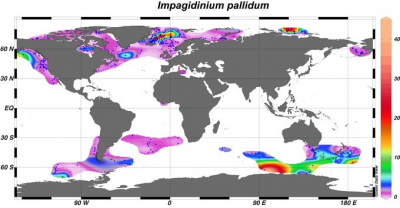Page path:
- Modern Dinocyst Key
- transparent cysts
- Paratabulation reflected by septa
- low septa of uniform height
- Impagidinium pallidum
Impagidinium pallidum
Zonneveld, K.A.F. and Pospelova V. (2015). A determination key for modern dinoflagellate cysts. Palynology 39 (3), 387- 407.
Field Characteristics
Impagidinium pallidum Bujak 1984
Field characteristics:
Proximochorate cyst with a spherical to polygonal body, a thin endophragm and a smooth to chagrinate wall surface. Sutural septa are thin, pale, smooth, with smooth, slightly undulating distal margins. Adcingular and sulcal borders are delineated by septa. Precingular archeopyle (plate 3").
Dimensions: Central body diameter: 49 to 63 µm; height of septa: 5 to 10 µm, occasionally up to10 µm.
Comparison with other species:
This species is often very hard to identify since it can be very thin. This species most closely resembles Impagidinium velorum but has much lower septa. In contrast to I. velorum both cingular margins are reflected by septa.
Field characteristics:
Proximochorate cyst with a spherical to polygonal body, a thin endophragm and a smooth to chagrinate wall surface. Sutural septa are thin, pale, smooth, with smooth, slightly undulating distal margins. Adcingular and sulcal borders are delineated by septa. Precingular archeopyle (plate 3").
Dimensions: Central body diameter: 49 to 63 µm; height of septa: 5 to 10 µm, occasionally up to10 µm.
Comparison with other species:
This species is often very hard to identify since it can be very thin. This species most closely resembles Impagidinium velorum but has much lower septa. In contrast to I. velorum both cingular margins are reflected by septa.
Geographic Distribution
Geographic distribution based on :
Zonneveld et al., 2013. Atlas of modern dinoflagellate cyst distribution based on 2405 datapoints. Review of Palaeobotany and Palynology, v. 191, 1-197
Zonneveld et al., 2013. Atlas of modern dinoflagellate cyst distribution based on 2405 datapoints. Review of Palaeobotany and Palynology, v. 191, 1-197
Impagidinium pallidum can be considered as a polar species that is typically present in regions that have high phosphate and nitrate concentrations but low Chlorophyll-a concentrations in upper waters and well ventilated bottom waters. It can be present in high relative abundances in sites that are seasonally covered with sea ice and where upper water salinities can be reduced seasonally.

Distribution:
With exception of two recordings in the central Mediterranean and equatorial Atlantic, the distribution of Impagidinium pallidum is bipolar with maximal relative abundances up to 39% in Arctic and Antarctic polar waters and in the vicinity of the polar fronts. It has high relative abundances in regions where large seasonal contrasts exist. It can be observed in coastal sites as well as in the central oceans.
Environmental parameters:
SST: -2.1 - 25.7°C (spring - spring). SSS: 17.4 - 38.0 (summer - summer), [P]: 0.09 - 2.10 μmol/l, [N]: 0.19 - 30.6 μmol/l, chlorophyll-a: 0.05 - 3.56 ml/l, bottom water [O2]: >1.7 ml/l.
Highest relative abundances > 20% can be observed in regions with temperatures between -1.7 - 5.4°C (winter - summer). I. pallidum is observed in sites where salinities can be seasonally reduced as a result of melting of ice. It is characteristically observed in regions with high upper water [P] and [N] but low chlorophyll-a concentrations. It is restricted to sites where bottom waters are well ventilated.
Comparison with other records:
In records other than included in this Atlas, I. pallidum is generally observed in polar to temperate regions in consistence with our observations (Mudie, 1992; Solignac et al., 2009; Patterson et al., 2011). It is abundant in sediment trap samples recovered below the East Greenland Current and can be observed in areas that are covered with sea ice up to 12 months a year that can be characterised by reduced salinities in spring and summer as a result of melting events (Dale et al., 2002; de Vernal et al., 1998; Radi and de Vernal, 2008; Solignac et al., 2009).
With exception of two recordings in the central Mediterranean and equatorial Atlantic, the distribution of Impagidinium pallidum is bipolar with maximal relative abundances up to 39% in Arctic and Antarctic polar waters and in the vicinity of the polar fronts. It has high relative abundances in regions where large seasonal contrasts exist. It can be observed in coastal sites as well as in the central oceans.
Environmental parameters:
SST: -2.1 - 25.7°C (spring - spring). SSS: 17.4 - 38.0 (summer - summer), [P]: 0.09 - 2.10 μmol/l, [N]: 0.19 - 30.6 μmol/l, chlorophyll-a: 0.05 - 3.56 ml/l, bottom water [O2]: >1.7 ml/l.
Highest relative abundances > 20% can be observed in regions with temperatures between -1.7 - 5.4°C (winter - summer). I. pallidum is observed in sites where salinities can be seasonally reduced as a result of melting of ice. It is characteristically observed in regions with high upper water [P] and [N] but low chlorophyll-a concentrations. It is restricted to sites where bottom waters are well ventilated.
Comparison with other records:
In records other than included in this Atlas, I. pallidum is generally observed in polar to temperate regions in consistence with our observations (Mudie, 1992; Solignac et al., 2009; Patterson et al., 2011). It is abundant in sediment trap samples recovered below the East Greenland Current and can be observed in areas that are covered with sea ice up to 12 months a year that can be characterised by reduced salinities in spring and summer as a result of melting events (Dale et al., 2002; de Vernal et al., 1998; Radi and de Vernal, 2008; Solignac et al., 2009).


